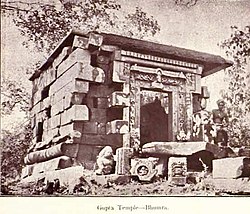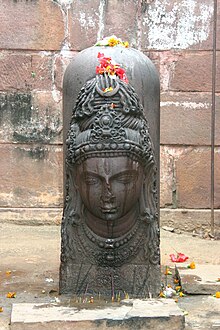Bhumara
| Bhumara भुमरा |
||
|---|---|---|
|
|
||
| State : |
|
|
| State : | Madhya Pradesh | |
| District : | Satna | |
| Sub-district : | Unchehara | |
| Location : | 24 ° 26 ' N , 80 ° 42' E | |
| Height : | 530 m | |
| Area : | 6.91 km² | |
| Residents : | 115 (2011) | |
| Population density : | 17 people / km² | |
| Bhumara - Shiva Temple (1920) | ||
Bhumara (sometimes also called Bhummra or Bhubara , Hindi : भुमरा) is a place in the Indian state of Madhya Pradesh consisting of only a few houses and a stone temple from the Gupta period .
location
The place and temple of Bhumara are located on a hill plateau about 530 m high, largely overgrown with bushes, about 27 km (driving distance) northwest of the small town of Unchehara , which also has a regional train station. Bhumara can also be reached from Nagod by taxi. In contrast to Nachna , which is only 45 km away , the temple of Bhumara stood isolated in what has probably always been a sparsely populated area.
history
Little is known about the earlier history of the place and the temple due to the lack of written records; the Shiva temple was apparently built towards the end of the 5th century. At some point in medieval times it was badly damaged - probably by human hands. It was not until 1920 that the temple was rediscovered by English archaeologists; some decorated components were already brought to the Indian Museum in Calcutta . In 1979 extensive restoration and reconstruction measures took place, through which the original appearance of the temple was almost restored (photo → web link).
Dating
The temple dedicated to God Shiva is not dated either by building inscriptions or by written documents. Despite clear structural similarities with the early temples of Tigawa and Sanchi (Temple No. 17) it is mostly dated to the late 5th century (approx. 480) due to the presence of a high platform and the developed figure style.
Shiva temple
architecture
The Shiva temple of Bhumara stands on an approximately 1.40 m high platform ( jagati ) , the dimensions of which are comparable to those of the two temples of Nachna . The square windowless cella ( garbhagriha ) of the temple, which was built from precisely hewn red sandstone blocks (external dimensions approx.3.70 m × 3.70 m; internal dimensions approx. 3 m × 3 m) is completely unstructured both inside and outside, and had a comparatively small wall thickness (approx. 70 cm) and was laid flat; an open vestibule supported by pillars ( mandapa ) was in front of it, so that the original impression was comparable to the temples of Tigawa and Sanchi. Two foundation structures can be seen on both sides of the staircase, which suggest the former presence of two smaller accompanying shrines.
Architectural jewelry
The portal wall is graduated several times; all parts are richly decorated with figure reliefs ( Ganga and Yamuna as well as male and female figures in separate fields) and ornaments. The door lintel ( lintel ) is optically widened and presents a large Shiva bust in the middle, the quality of which is comparable to the one on the lingam; to the side there are heavenly lovers ( mithunas ) . Some parts of a decorative frieze decorated with vegetable motifs and servants have also been preserved.
Shiva lingam
The most important attraction of Bhumara is a Shiva lingam with a bust relief of the god, which takes up almost the entire height of the lingam; it is one of the oldest images of Shiva ever. The youthful face of Shiva with his half-open eyes radiates calm and sovereignty and shows the god, whose nickname also includes “Lord of the Yogis” (yogeshvara) , in meditation. A third eye can be seen on Shiva's forehead, which is an external feature of inner knowledge and wisdom, but with which he can also burn his opponents to ashes.
The long braids of hair of the god portrayed as a “moon wreath” (chandrashekar) are pinned up to an extremely richly decorated braid crown and are held by a jeweled diadem ; The conclusion is a crescent moon, which he received while the ocean of milk was whisking. Some loose strands of hair hang down the sides of the head to the shoulders and cling to the side of the lingam. Shiva's neck, hung with jewelry, is - as is common with many earlier and also contemporary Buddha and Tirthankara images - designed in the form of three rings.
The lingam, which was probably made in the late 5th century, is exceptionally well preserved; only the god's nose was later chopped off - probably by human hands.
meaning
The Gupta temple of Bhumara is one of the few remaining or partially reconstructed buildings from this period. The portraits of Shiva on the lingam and in the lintel are of exceptional technical perfection and great artistic expressiveness.
Surroundings
Not far from the temple is a pillar dated to the end of the 5th or beginning of the 6th century (thari pathar) ; it contains an inscription that delimits the domains of two Maharajas from one another.
See also
literature
- RD Banerji: The Temple of Siva at Bhumara. Memoirs of the Archeological Survey of India No 16. New Delhi 1998
- Michael W. Meister u. a. (Ed.): Encyclopaedia of Indian Temple Architecture. North India - Foundations of North Indian Style. Princeton University Press, Princeton 1988, ISBN 0-691-04053-2 , pp. 40ff.
Web links
Individual evidence
- ↑ Bhumara - Village Info
- ↑ Bhumara - Map with altitude information
- ↑ Anneliese and Peter Keilhauer: The visual language of Hinduism. The Indian world of gods and their symbolism . DuMont, Cologne 1986, ISBN 3-7701-1347-0 , p. 112
- ↑ Anneliese and Peter Keilhauer: The visual language of Hinduism. The Indian world of gods and their symbolism . DuMont, Cologne 1986, ISBN 3-7701-1347-0 , p. 139.



